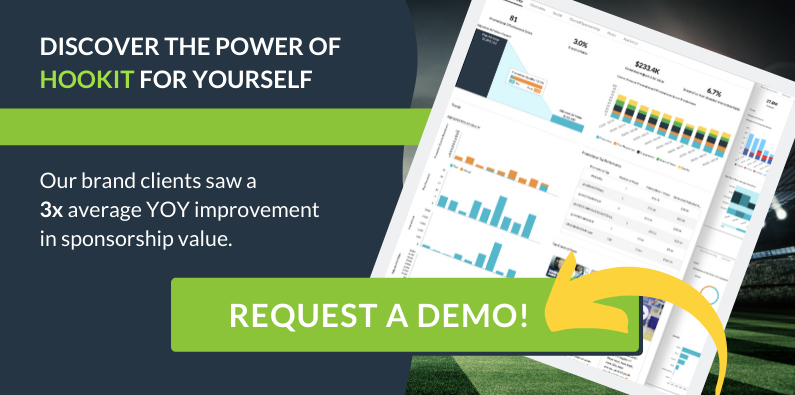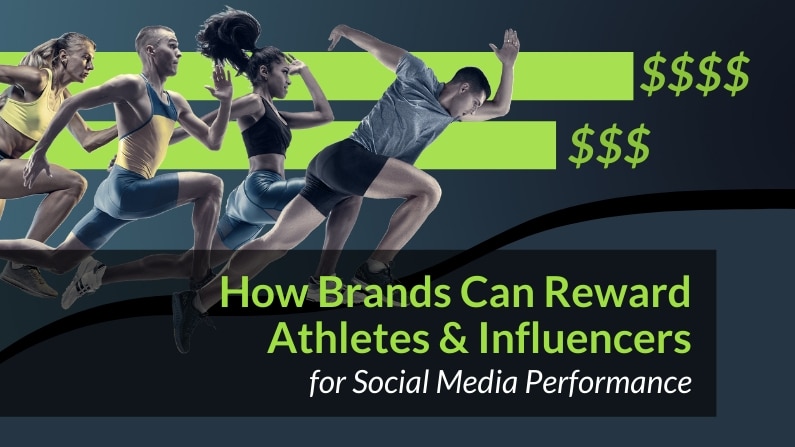6 Steps To Implementing Sponsorship Incentives Into Athlete Contracts
With consumers increasingly avoiding any kind of advertising that comes their way, brands are looking to their athletes and influencers to promote and endorse them on their social media channels to their intended audiences. This makes it essential for brands to provide incentives to their partners to ensure that the ambassador promotes the brand properly. No matter what type of ambassador a brand works with, brands can gamify the structure to make sure partners are promoting the brand in the best way possible. To do this, brands need to set specific KPIs and make sure the ambassador meets these set objectives to gain sponsorship incentives.
Many top brands are already implementing performance-based sponsorships for their partners. Here’s how the performance-based sponsorship model works:
- Sponsor brands set certain objectives that sports properties need to meet, such as certain levels of engagement on social media or increased brand awareness within that market.
- The properties are then paid or provided with incentives when they reach the goals set by the sponsor.
- Goals are set based on discussions between the sponsor and properties and this ensures that properties understand the goals and expectations of the sponsor and vice-versa.
Hookit’s 6 step plan helps brands set up a foolproof method to ensure that their sponsorship dollars are well spent and brand ambassadors achieve the brand’s set goals.
Step 1: Identify the essential metrics for your brand
One of the key components of incentive-based sponsorships is the ability to identify and measure the sponsorship metrics that matter, to ensure that the sponsored properties meet the objectives of the sponsor, i.e., true alignment that is essential for success. There are various metrics available to measure the effectiveness of a partnership. However, most of these popular metrics may be vanity metrics — they are flashy metrics which look good but have little to no impact for a brand’s goals. (For example, social media impressions or the number of times the post was displayed, may seem like a great metric with a huge number, but does not always translate and contribute to a tangible value to the overall goals of the company).
As a brand marketer, it is important to identify primary metrics that further your organization’s goals, then monitor and measure them accurately. Some essential metrics needed to measure sponsorship impact (in order from best to good) are:
Adjusted Ad Value (AAV)
This is one of the best metrics that provides a brand with an immediate dollar value that the brand earned from its ambassador’s promotions on social media. To accurately gauge the value a sponsor earns from its branded posts, Hookit employs its proprietary Hookit Valuation Model (HVM).

The HVM starts with the Maximum Ad value (MAV), which is the total value the brand could earn from that particular social post based on total engagement on that post. This MAV is then down weighted by the post’s quality of promotion to arrive at the Adjusted Ad Value (AAV). It is therefore important to ensure that branded posts have good promotion quality to maximize their value. Get the full details of the Hookit Valuation Model here.
Promotional Effectiveness Score
A brand ambassador may be promoting their sponsor on their social channels, but it is important to measure if that promotion is effective and adds value to the brand. To do this, Hookit developed the Promotional Effectiveness Score (PE Score), a composite score out of 100 that looks at how effective an entity is at promoting a specific brand, regardless of their follower count. The PE score is made up of 5 sub-scores that measure an entity’s social post performance.

It is a way to compare entities on a level playing field by examining the quality of their promoted posts, the regularity with which they are promoting, and how their promoted content performs relative to the rest of their content. Learn more about the PE score here.
Promotion Quality
Sometimes an ambassador will have many followers and generate high engagement with their followers, but the value that they drive to their sponsored brand may be minimal. This can be attributed to poor promotion quality of the ambassador’s posts. Proper mentions of brand hashtags and the brand’s social handle, as well as images that feature clear brand logos have higher promotion quality and lead to more value for the brand.

Here are three examples of posts with low, high, and highest promotion quality. On the left, the post has no clear brand logo and any brands mentioned get lost in the sea of hashtags. The middle post has a brand logo at the end of the video as well as multiple tags of the promoted brand, in this case, Rolex. Finally, on the right, multiple brand logos are visible in the picture and the text is uncluttered including a brand hashtag, leading to a very high promotional quality score.
Total number of engagements
Social media engagements on an ambassador’s branded post is a good metric for brands to track. This metric shows the brand how influential the ambassador is, and how well audiences interact with the ambassador on social media. High engagements paired with high promotion quality on an ambassador’s branded posts will earn the highest value for a brand. However, this is the least effective of the mentioned metrics because it is heavily dependent on the number of followers that an ambassador has. This can lead to deceivingly high numbers for the more popular athletes who don’t actually promote a brand partner in a good way.
See more examples of other metrics that can be used to measure sponsorship performance here.
Step 2: Setting benchmarks
Brands need to set certain benchmarks to ensure that brand ambassadors are enabling the brand’s goals. Brands invest heavily in their brand ambassadors and setting benchmarks helps brands measure the performance of its ambassadors in a meaningful and practical way. That way, during and at the end of a contract, both sides can have clear expectations on whether the partnership was successful and whether it should be renewed.These benchmarks should be set with the brand’s end goal in mind. For example, if a brand’s goal is to increase its engagement and brand recall, then the brand ambassador’s goal can be an increase in their social media engagements by x% compared to the previous year. If the brand goal is to reach new audiences, then the brand ambassador’s goal is to gain more followers from a particular gender/country/ethnicity. The brand can then reward incentives based on how well the ambassadors have achieved their goals, such as the top 20% of ambassadors get a bonus, or an automatic contract renewal, and so on. More on benchmarking here.
Step 3: Empower your athletes with data
Most top brands are already monitoring the social media performance of their ambassadors using Hookit’s real time dashboard. The dashboard helps brands identify the best and worst performers, learn about best performing social posts as well as keep track of their ambassadors’ performance in relation to the brand’s goals. While sharing examples of the best branded posts to each ambassador is a good first step, those posts may need tweaking based on the ambassador’s audience and interests.However, brands can further improve the performance of their ambassadors by empowering them with the data they need to keep track of their sponsor obligations. Brands can invite their sponsored athletes to monitor their own performance through Hookit’s Pro Account.

Using the Hookit Pro Account, athletes and influencers of the brand can access in-depth data about their social performance, see how they stack up against other top athletes in their sport, learn more about their audiences, and also keep track of whether or not they are meeting the sponsorship obligations set for them. Learn more about how to invite your ambassadors.
Step 4: Decide the reward
Rewards for hitting the set goals should be substantial enough for athletes and other partners to want to hit the goal. Small reward for an extraordinary amount of brand promotion is not likely to motivate partners. However, meaningful rewards can both encourage partners to promote your brand and improve their happiness with the partnership and loyalty to your brand. Each brand’s reward structure is as unique as the benchmarks set out to achieve.
And yet, this is the section where many brands hesitate, when they consider the concept of giving out more money than the minimum contracted for. However, top brands, like AB InBev mentioned in the article above, include payouts of ALL incentives into their budget so they know what they could possibly be spending. This method avoids any possible end of year surprises or budget overruns, something your finance department and top executives will thank you for.
Step 5: Let athletes and influencers share your brand story
For any brand, some ambassadors will be highly effective at driving value while others may not. As every ambassador represents a significant investment from the brand’s perspective, there are certain ways through which the sponsor brand can ensure that its ambassadors meet their set goals.
- Choose branded posts by ambassadors that are most engaging or are high value drivers for the brand. Use these posts as best practice examples or inspiration to coach athletes/influencers who are lagging behind. This provides ambassadors with a good set of example posts that work and can help them significantly improve the value they drive for your brand.
- Encourage ambassadors to share the brand’s content on their channels. This provides content for the ambassador, while getting the brand in front of the ambassador’s audiences.
Since athletes/influencers want to gain incentives and rewards, any support provided from the brand’s side to help them tell the brand story and achieve the agreed upon goals is a win-win for both sides of the sponsorship.
Step 6: Review your results
It is important to review partner content to ensure that they are on-track or have reached their set goals. These reviews help the brand understand what’s working and what’s not as well as who is on track to earn incentives. Brands can encourage ambassadors to continue the types of posts that work, while helping ambassadors tweak posts that don’t produce the desired value.
These ambassadors are the brand’s investments, so brands should encourage them to always produce content that shows the brand in the best possible light, improves engagement with their followers, and earns the highest brand value.
Takeaways
Hookit works with top brands invested in sponsorship and influencers to provide them with easy ways to monitor, measure, and review the performance of all its ambassadors. By following these 6 simple steps, brands have reported
- Significant increase in promotion and production from their sponsored entities resulting in increased brand value
- Happier athletes and influencers who understand exactly what the brand expects from them, resulting in substantial earnings from brand incentives.
This leads to a win-win for both sides of the sponsorship.
Hookit is a trusted third party by many top brands in the sponsorship industry and has the tools needed by a brand at every step of its sponsorship. Contact us to gain access to these tools and grow your brand value today!



